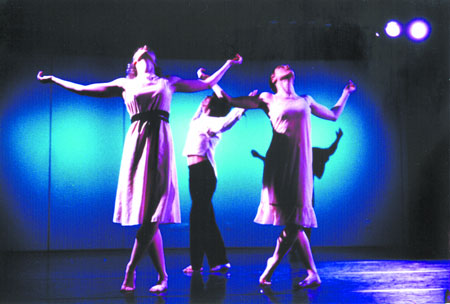Tiffany Mills raises many ideas, but offers no overarching structure
A Stop and Go Dynamic
Stephanie King, Matsuhide Nakashima, and Tiffany Mills.
Is that it… all there is? This was the question burning in the minds of the audience on Friday night after a half hour of dance, music, and film that came after a half hour of delay. Was this the intermission? Who would know, since they didn’t even have programs to give everyone in the audience?
Whatever. It was over. Time to clap for art and go home. Many ideas were staged by Tiffany Mills and her company of fine dancers on HERE’s warm main stage space in “Elegy.” But none of them seemed to connect or even try to. Like the stop and go dynamic of the movement, there did not seem to be attention to any whole experience.
Harnesses and riggings were used for a silent, somnambulant aerial prologue performed by the ensemble, which had a moment of spinning beauty, one body inciting and joining another in rotation, just before the ending. This was followed by a silent solo by Matsuhide Nak-ashima, who had not heretofore been attached to any ropes. He fondled the carabiner like it had been held in the hand of his lover, mourning the loss of his counterweight. But this direction evaporated, and with a blackout and a sudden blast of John Zorn music, we were thrust into the body of this quizzical and very short dance. The costumes—cropped formal wear, sheer and slinky creams, and blacks with accents—suggested more a gala than a funeral.
Maurice Fraga played an emotionally troubled character, ostensibly the dead man who was being honored, becoming aware of his inexplicable difference. Either way, the moments of pathos generated by his skilled performance were no match for where the work took him from there. After not bumping into the other dancers, and then really bumping into them, he joined them in unison phrases, all jumping, half turns, and swinging into arabesque shapes. Get it?
Zorn’s score directed the energy of the work, which perhaps was part of its problem—the result was too literal an approach to interpretation. But within the cacophony of the music, there is still a structure, but little structure beyond one motionless motif presented itself in the dance. Paradoxically, watching the background video, made by independent great Ela Troyano, was exciting. A congealing visual poem, filled with awkward and graceful images, gritty and wet, dark and clear, created from scratch and extracted from elements in the dance and expanded in an unabashedly abstract way. It was both a satisfying complement to the music and a reminder of the filmmaker’s roots in experimentalism—long before “Latin Boys Go to Hell.”
The performers included Ryan Corriston, Jeffrey Duval, Laura Hymers, Stephanie King, and Ms. Mills. The video was photographed by James Carman and edited by Josh Cramer.


































